Laser BPH Devices Market Research, 2031
The global laser bph devices market was valued at $460.3 million in 2021, and is projected to reach $765.4 million by 2031, growing at a CAGR of 5.2% from 2022 to 2031. Benign prostatic hyperplasia (BPH), often known as enlargement of the prostate gland, is a common ailment that affects men as they age. Uncomfortable urinary symptoms including a blocked urine flow from the bladder might be brought on by an enlarged prostate gland. It may also result in issues with the kidneys, bladder, or urinary system. Although the intensity of symptoms varies among those with enlarged prostate glands, they typically get worse over time. The inability to completely empty the bladder, frequent or urgent urination, increased nighttime urination, difficulties starting urination, weak urine flow or a stream that stops and begins, dribbling at the conclusion of urination, and difficulty initiating urination are all common indications and symptoms of BPH.
Laser devices such as holmium laser, thulium laser, green light laser, and others such as diode laser, ND: YAG laser, and KTP/Nd: YAG laser are used to treat benign prostatic hyperplasia.
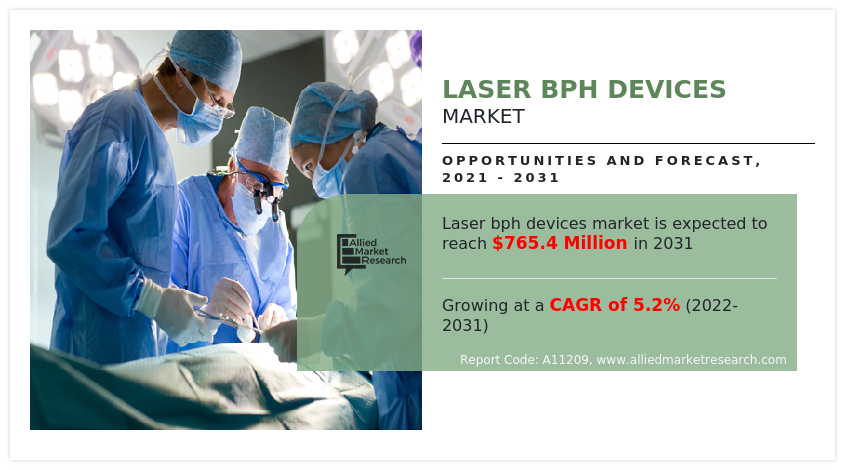
Historical overview
The laser BPH devices market size was analyzed qualitatively and quantitatively from 2021 to 2031. The laser benign prostatic hyperplasia devices market experienced growth at a CAGR of around 5.2% from 2022 to 2031. Most of the growth during this period was derived from the North America owing to the rise in the number of laser BPH devices industry who manufacture laser BPH devices, increase in disposable incomes, as well as well-established presence of domestic companies in the region.
Market Dynamics
Growth of the global Laser BPH devices market size is majorly driven by increase in the prevalence of benign prostatic hyperplasia, rise in the prevalence of obesity and diabetes and rise in the geriatric population. Benign prostatic hyperplasia (BPH) causes the prostate to increase in size. It is the most common prostate problem in men as they age. Symptoms include difficulty peeing and a sudden need to pee. Treatment includes medications, surgery and minimally invasive procedures and laser procedures like photoselective Vaporization of the Prostate (PVP) and holmium laser ablation of the prostate (HoLAP). Thus, rise in the prevalence of benign prostatic hyperplasia is anticipated to drive the growth of laser BPH devices market. For instance, according to report shared by The Lancet Article, in 2019, approximately 94 million population is suffering from benign prostatic hyperplasia over the globe. In addition, as per the same source, it was reported that, in North America around 51,90,000 population is suffering from benign prostatic hyperplasia in 2019. Moreover, the cases were approximately increased by 68% from year 2000. Thus, this factor is anticipated to drive the demand for different laser BPH devices such as holmium laser, thulium laser, green light laser and others which includes diode laser, ND: YAG laser, KTP/Nd: YAG laser.
Geriatric population is majorly susceptible to suffer from benign prostatic hyperplasia (BPH). The prostate gland continues to grow during adult life. That is why BPH is the most common prostate condition in people over age 50. As the prostate gets bigger, it may press against the bladder and pinch the urethra. This can slow or block the flow of urine out of the bladder. Over time, the bladder muscle may become weak from trying to pass urine through a narrow urethra. When this happens, the bladder may not empty completely after urination. A narrowed urethra and weak bladder cause many of the urinary problems with BPH. Thus, rise in number of geriatric population cause increase in prevalence of benign prostatic hyperplasia. Therefore, this factor is anticipated to drive the market growth. For instance, according to the U.S. Census Bureau data published in December 2021, more than 56 million adults ages 65 i.e., 16.9% of the nation’s population and by 2050 is estimated to rise 85.7 million. Moreover, according to report shared by World health Organization (WHO), it was reported that, population aged 60 years and over will increase from 1 billion in 2020 to 1.4 billion over the globe. As per the same report, it was estimated that, by 2050, the world’s population of people aged 60 years and older will double (2.1 billion).
Rise in the prevalence of obesity will increase the risk of benign prostatic hyperplasia (BPH). Obese men have a higher risk for BPH. Obesity causes several mechanisms including increased intra-abdominal pressure, altered endocrine status, increased sympathetic nervous activity, increased inflammation process, and oxidative stress, all of which are favorable in the development of BPH. Increased sympathetic nervous activity in central obesity has been known to influence the development of BPH and the severity of urinary obstructive symptoms. Thus, rise in prevalence of obesity is anticipated to increase in incidence of BPH and drives the market growth. For instance, according to World Obesity Atlas 2022, the number of male populations with more than 30 BMI (Body Mass Index) is 434 million globally. In addition, as per the same source, it was estimated that, 1 in 7 men, will be living with obesity by 2030. Increase in the prevalence of diabetes can leads to rise in risk of benign prostatic hyperplasia (BPH). Diabetes is reported to be associated with greater BPH symptom severity. Men with non-insulin-dependent diabetes had the highest median annual prostate growth rate compared with those who had other metabolic disease. Systemic inflammation and oxidative stress caused by diabetes can cause prostatic hyperplasia. Thus, this factor is anticipated to drive the market growth.
On the other hand, side effects associated with laser benign prostatic hyperplasia (BPH) surgery is anticipated to hamper the growth of laser BPH devices market. For instance, side effects such as temporary difficulty urinating, urinary tract infection, narrowing (stricture) of the urethra, dry orgasm, erectile dysfunction need for retreatment are anticipated to decrease the acceptance of laser BPH surgery. Therefore, this factor is anticipated to have negative impact on the laser BPH devices market. In addition, high cost of laser benign prostatic hyperplasia (BPH) surgery is anticipated to have negative impact on the growth of laser BPH devices market. For instance, according to the data shared by PACE Hospital, Hyderabad, India, it was reported that, the average cost of laser surgery for enlarged prostate or holmium laser ablation of the prostate procedure may vary from $1,694.6 to $2,299.9. Therefore, this factor is anticipated to hamper the growth of the market.
Segmental Overview
The laser BPH devices market share is segmented into Type, Procedure and End User. Based on type the market is segmented into holmium laser, thulium laser, green light laser, and others. On the basis of procedure, the market is segmented into photo selective vaporization of the Prostate (PVP) and holmium laser ablation of the prostate (HoLAP). On the basis of end user, the market is segmented into hospitals, clinics, and others. Region-wise, the market is analyzed across North America, Europe, Asia-Pacific, and LAMEA.
Based on type, the market is segmented into holmium laser, thulium laser, green light laser, and others. The holmium laser segment dominated the market in 2021 and is expected to continue this trend during the forecast period, owing to rise in number of product launch and products approvals for holmium laser and increase in number of companies who manufactures laser BPH devices.
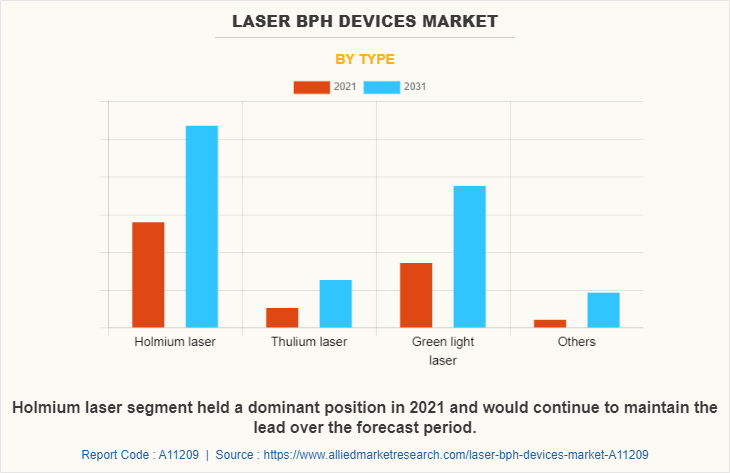
Based on procedure, the market is bifurcated into photoselective vaporization of the Prostate (PVP) and holmium laser ablation of the prostate (HoLAP). The holmium laser ablation of the prostate (HoLAP) segment dominated the market in 2021 and is expected to continue this trend during the forecast period, owing to increase in the prevalence of benign prostate hyperplasia and rise in the application of photoselective vaporization of the prostate (PVP) is a laser procedure.
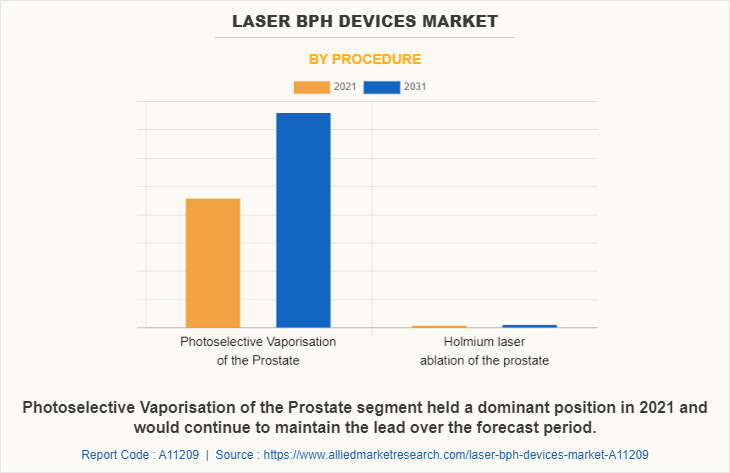
Based on end user, the market is divided into hospitals, clinics, and others. The hospitals segment dominated the market in 2021 and is expected to continue this trend during the laser BPH devices market forecast period, owing to rise in expenditure by government to develop healthcare infrastructure and increase in number of hospitals and clinics.
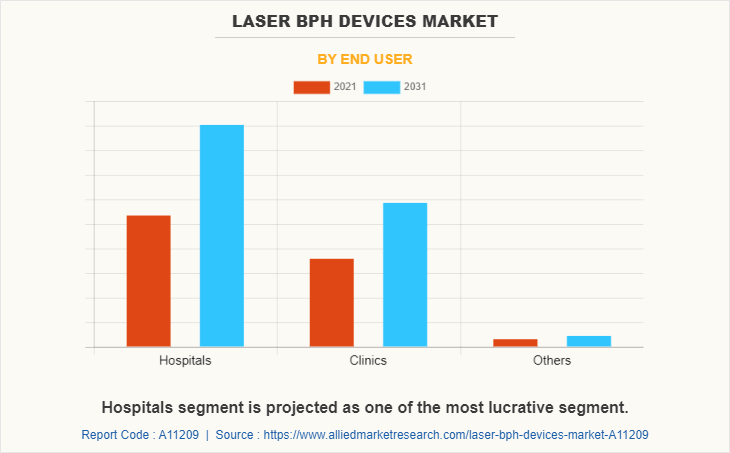
North America laser BPH devices market is expected grow during the forecast period owing to increase in the number of populations suffering from benign prostatic hyperplasia, rise in the number of benign prostatic hyperplasia industry who manufactures laser BPH devices. Moreover, Boston Scientific, Agiliti Health, Inc., Endo Pharmaceuticals Inc., HealthTronics, Inc. and OmniGuide are some market players who are engaged in manufacturing high technology laser BPH devices.
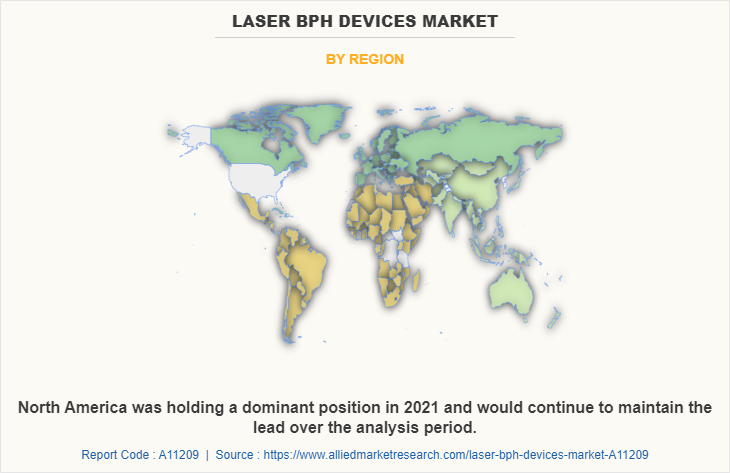
In addition, geriatric population is more susceptible to neurological diseases. Thus, rise in number of geriatric populations is anticipated to fuel the demand for EEG electrode and drives the laser BPH devices market growth. For instance, according to the U.S. Census Bureau, more than 56 million adults ages 65 and over in U.S. By 2030, it is projected to reach 73.1 million older adults.
Moreover, rise in expenditure by government to develop healthcare infrastructure and increase in awareness among people regarding hospital acquired infection is anticipated to fuel the market growth. For instance, according to the Centers for Medicare & Medicaid Services, the U.S. health care spending grew by 9.7% from 2019 to 2020, reaching $4.1 trillion ($12,530 per person).
Moreover, rise in prevalence of obesity and increase in prevalence of diabetes in men is anticipated to increase in incidence of benign prostatic hyperplasia. Thus, this factor is anticipated to drive the growth of market. For instance, according to International Diabetes Federation, in 2021, it was reported that, in North America 1 in 7 adults (51 million) are living with diabetes. The number of adults with diabetes is expected to reach 57 million by 2030 and 63 million by 2045. Thus, increase in prevalence of diabetes cause rise in risk of BPH and drives the demand for laser BPH devices. Therefore, this factor is anticipated to drive the growth of market in North America
Asia-Pacific laser BPH devices market is expected to grow in the forecast period owing to rise in the number of populations suffering from benign prostate hyperplasia and rise in the number of adoptions of key strategies such as acquisition, partnership, agreement, and business expansion by market players. For instance, in May 2021, Olympus corporation, medical equipment manufacturing company, announced the acquisition of Medi-Tate, Medical Device Company. Through this acquisition, Olympus expands its business line in offering in-office treatment for benign prostatic hyperplasia (BPH) treatment and solidifies its position as a leader in the field of urological devices.
Rise in the number of product launch and product approvals for laser BPH devices is anticipated to drive the growth of market. For instance, in July 2020, Lumenis Ltd., the world’s largest energy-based medical device company for aesthetic, surgical and ophthalmic procedures, announced the launch of MOSES 2.0 holmium laser technology to treat benign prostatic hyperplasia.
Moreover, rise in the number of people suffering from diabetes is anticipated to increase the risk of benign prostatic hyperplasia and drives the market growth. For instance, according to, International Diabetes Federation, in 2021, in Southeast Asia 1 in 11 adults (90 million) are living with diabetes. The number of adults with diabetes is expected to reach 113 million by 2030 and 151 million by 2045.
COMPETITION ANALYSIS
Some of the major companies that operate in the Laser BPH devices market include Boston Scientific, Agiliti Health, Inc., Asclepion Laser Technologies GmbH, Biolitec AG., Coloplast, Endo Pharmaceuticals Inc., HealthTronics, Inc., Lumenis, Metrum Cryoflex, OmniGuide and Richard Wolf GmbH.
Some examples of product launch in the market
In July 2020, Lumenis Ltd., the world’s largest energy-based medical device company for aesthetic, surgical and ophthalmic procedures, announced the launch of MOSES 2.0 holmium laser technology to treat benign prostatic hyperplasia.
Some examples of acquisition in the market
In July 2020, Lumenis Ltd., the world’s largest energy-based medical device company for aesthetic, surgical and ophthalmic procedures, announced the launch of MOSES 2.0 holmium laser technology to treat benign prostatic hyperplasia.
Key Benefits For Stakeholders
- This report provides a quantitative analysis of the market segments, current trends, estimations, and dynamics of the laser bph devices market analysis from 2021 to 2031 to identify the prevailing laser BPH devices market opportunity.
- The market research is offered along with information related to key drivers, restraints, and opportunities.
- Porter's five forces analysis highlights the potency of buyers and suppliers to enable stakeholders make profit-oriented business decisions and strengthen their supplier-buyer network.
- In-depth analysis of the laser bph devices market segmentation assists to determine the prevailing market opportunities.
- Major countries in each region are mapped according to their revenue contribution to the global market.
- Market player positioning facilitates benchmarking and provides a clear understanding of the present position of the market players.
- The report includes the analysis of the regional as well as global laser bph devices market trends, key players, market segments, application areas, and market growth strategies.
Laser BPH Devices Market Report Highlights
| Aspects | Details |
| Market Size By 2031 | USD 765.4 million |
| Growth Rate | CAGR of 5.2% |
| Forecast period | 2021 - 2031 |
| Report Pages | 239 |
| By Type |
|
| By Procedure |
|
| By End User |
|
| By Region |
|
| Key Market Players | Metrum Cryoflex, Richard Wolf GmbH, Coloplast, OmniGuide, HealthTronics, Inc., Biolitec AG, Agiliti Health, Inc., Endo Pharmaceuticals Inc., Teleflex Incorporated, Boston Scientific Corporation |
| Other Players | Winter IBE GMBH, |
Analyst Review
Benign prostatic hyperplasia (BPH), also called prostate enlargement, is a non-cancerous increase in size of the prostate gland. Laser procedures such as photoselective vaporization of the Prostate (PVP), holmium laser ablation of the prostate (HoLAP) is used to treat benign prostatic hyperplasia
Increase in the number of product launch and product approvals for laser BPH devices and rise in the number of adoption of strategies such as collaboration, acquisition, and partnership by market players drives the market growth. For instance, in July 2020, Lumenis Ltd., the world’s largest energy-based medical device company for aesthetic, surgical and ophthalmic procedures, announced the launch of MOSES 2.0 holmium laser technology to treat benign prostatic hyperplasia.
The top companies that hold the market share in Laser BPH Devices market are Boston Scientific, Agiliti Health, Inc., Asclepion Laser Technologies GmbH, Biolitec AG., Coloplast, Endo Pharmaceuticals Inc., HealthTronics, Inc., Lumenis, Metrum Cryoflex, OmniGuide and Richard Wolf GmbH.
Asia-Pacific is anticipated to witness lucrative growth during the forecast period, owing to rise in expenditure by government organization to develop the healthcare sector and increase in awareness regarding benign prostate hyperplasia.
The key trends in the Laser BPH Devices market are increase in the prevalence of benign prostatic hyperplasia, rise in the prevalence of obesity and diabetes and rise in the geriatric population
The base year for the report is 2021.
Yes, Laser BPH Devices companies are profiled in the report
The total market value of Laser BPH Devices market is $460.2 million in 2021 .
The forecast period in the report is from 2022 to 2032
The market value of Laser BPH Devices market in 2022 was $483.7 million
Loading Table Of Content...



